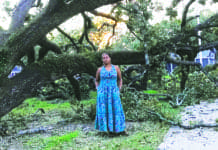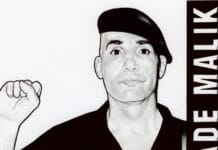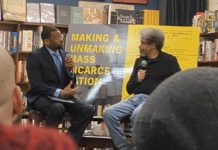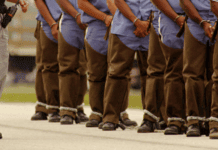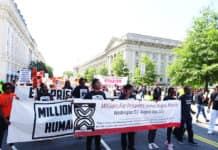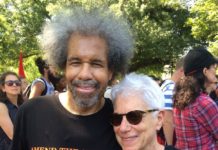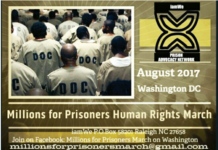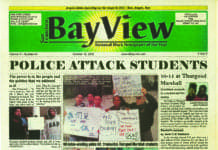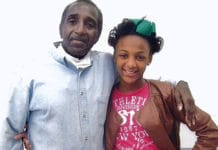
26 years of letters, art, inspiration and loving friendship between Herman Wallace and Sharon Willis
Interview by Willow Katz
Willow Katz: Sharon Willis, you corresponded for 26 years with Herman Wallace of the Angola 3. Who are the Angola 3?
Sharon Willis: The Angola 3 are three Black men: Herman Wallace, Albert Woodfox and Robert Hillary King. In 1972, Herman Wallace and Albert Woodfox were accused of killing a young prison guard in Louisiana State Prison in Angola, Louisiana. They were put in solitary confinement. Later, Robert Hillary King was brought to Angola and also put in solitary. They were all charged and convicted of the murder, becoming known as the Angola 3.
Many, many people, including the guard’s wife, who was 17 years old when her husband was killed, believe that there is proof and evidence the Angola 3 did not kill the guard.
I think the prison punished them for promoting Black Panther ideals. They were standing up to the prison establishment and saying this is wrong; we are not going along with it. The prison establishment did not like that. The prison punished the Angola 3 for simply being Black.
Willow: What did Herman Wallace first say to you?
Sharon: I had sent him a Christmas card. He thanked me. He told me about the murder of the prison guard and that he and the other two did not commit the murder. He told me about his life in solitary in the prison and about his life before prison.
I enjoyed his appreciation, personality and writings, so I wrote him back. At that time, he was not as busy as he would be in later years. He had time to write to me and share his feelings and thoughts.
Willow: How did your correspondence with Herman develop?
Sharon: Our friendship evolved through writing each other and sharing about our lives. Herman had an engaging personality, so it was fun writing to him. It was good to connect in that way – through our histories.
He was sad about the bad things he went through. We compared where we were during certain moments in time.
In April 1972, I had my second child, when they were charging Herman with the murder of the guard. We were in very different places in our life stories. He always claimed that he did not do it, that it was a setup. He knew a lot of the backstory of what happened and why and who was involved. He knew the prison targeted him because he was promoting the Black Panther Party (BPP) as were his two comrades.
Willow: How do you think your correspondence affected Herman?
Sharon: He always expressed gratitude and appreciation that I was writing to him. When we began to correspond, Herman was at a low point – more isolated and withdrawn. I think our correspondence gave Herman human contact, a view of other people’s lives and a lift out of despair and hopelessness. It may have opened up the possibility that things do not have to stay the same forever. Being in solitary confinement for many years is not necessarily the end of life: When there is life, there is hope.
Herman told me that I expanded his horizons to see new possibilities and to fight for his freedom. He reached out to people. Many people got onboard, even famous people like Dame Anita Roddick, founder of [a] body care company The Body Shop. People fighting for justice for Herman gave him hope that someday he would be free.
Willow: How did your correspondence affect you and your family?
Sharon: My teenage daughter and I went to see the movie “Cry Freedom” about Steven Biko and the anti-apartheid movement in South Africa. The movie upset my daughter so much that she could not stop crying. I could not comfort her.
I asked Herman if he could console her. He wrote my daughter a hopeful letter. Herman talked about Angela Davis’ work and the work that other people were doing to improve things in the world. My daughter felt better after she read his letter. It showed me that even in the worst circumstances, locked away in solitary confinement, Herman could still reach out, inspire someone and enhance their life.
Willow: Did Herman express remorse for harm he did?
Sharon: Herman told me that he committed criminal acts before he went to prison. He stole, he intimidated people. He said it was wrong that he had frightened people with a gun.
Willow: Do you think Herman transformed himself from someone who harmed people?
Sharon: I believe Herman evolved through his life experiences. He sent me copies of court orders and legal documents. I briefly corresponded with one of his lawyers, Scott Fleming, who came to know Herman while working with him on his legal proceedings. At a hearing, the judge asked Scott if he would be willing to have Herman live with him and his family. Scott said, “Yes, of course.” Scott believed that Herman was very trustworthy.
Willow: Please tell us more about Herman’s life and character.
Sharon: Herman was born on Oct. 13, 1941, in New Orleans, before the attack on Pearl Harbor. He was a middle child of seven or eight children. He died in October 2013, just before his 72nd birthday.
Herman was outgoing. He told me about an incident when he was in grade school in the inner city of New Orleans in the early 1950s. He was between 9 and 12 years old. During a class discussion, a teacher said to Herman, “Who died and made you God?” That hurt him, even though it had happened over 60 years before. He was not trying to be God. He was just involved. That is how he was.
Herman asked the prison to let him go to his brother’s funeral but was denied. His mother also died while we were corresponding, and he asked to go to her funeral. The prison again denied permission.
Willow: Did Herman tell you about his family?
Sharon: Herman said that police killed his father when he was very little. He did not remember his father. Herman had many siblings and at least one sister came to see him in prison. She brought her teenage daughter once.
While I was corresponding with Herman, his brother died. He had been a New Orleans local elected official, maybe a council member. Herman asked the prison to let him go to his brother’s funeral. He longed to go but was denied. That upset Herman. His mother also died while we were corresponding, and he asked to go to her funeral. The prison again denied permission.
Willow: Did you ever talk with Herman on the phone?
Sharon: Herman called me collect every few months, except when he was in the hole. Then it could be six to eight months between phone calls. I was worried that the phone call was expensive, but I was happy to hear his voice. Herman was personable and dynamic. He was enthusiastic about working for his freedom and hopeful that he would be free someday. He was exuberant about being alive. He expressed joy. He made jokes. We laughed. He asked about my family.
Willow: Did you ever meet Herman in person?
Sharon: I never met Herman. In the early 1990s my husband and I went to the front gate of Angola Prison. A white man who worked there said something in a heavy Southern accent. The sound echoed off the metal guard building. I did not understand what he said. He never looked at me and I did not know that he was speaking to me.
Finally, a young white woman who worked there came up to me, smiling and friendly. She said I would not be able to see Herman; I needed to get a permit ahead of time. I told her I had applied several times for a permit. Sometimes the prison did not respond. Sometimes they said no. She said, “I’m sorry.” I left. I later wrote Herman what had happened. He was very angry.
I think they wanted to keep Herman isolated, to punish him for being Black and a Black Panther. The prison officials and many white people in Louisiana would do anything to inflict punishment on him. The attitude of punishment and control struck me. We are supposed to live in the land of the free.

Willow: What did Herman tell you about the Black Panther Party?
Sharon: Herman taught me about the higher aspirations of the Black Panther Party, the noble calling of the group, and their goals: equality for Black people, freedom, support, full citizenship and pride in who they are. Through Herman, I got to see some of how the BPP was working or supposed to work, and the potential to improve the lives of Black people and families. As a child of the 1960s, I knew about the Black Panthers, but Herman expanded on that to me. I could see how it would work in a real way. In prison, the Black Panther Party emphasized integrity, truthfulness, looking out for each other and helping and protecting one another.
Willow: How did Herman’s experiences affect you?
Sharon: Herman’s experiences opened my eyes to a facet of life that I knew practically nothing about before. I weighed it in my mind and contemplated it, gathering more information on my own. I researched the history of Black Panthers and the treatment of Black Panthers in prisons, particularly Angola, and general information about criminal justice. I used books, movies and articles in newspapers. I read various people’s biographies and autobiographies and accounts of their experiences in the criminal justice system.
Willow: What did your correspondence mean to you?
Sharon: Herman was a unique person who made a significant impact in my life. He changed my understanding of the legal system, what we call “crime,” people’s journeys through their lives. I have a deeper understanding of human nature and people’s circumstances. By corresponding with Herman, I learned more about how slavery and racism in the U.S. set the stage for institutional and ongoing racism today.
I am rather amazed that Herman and I corresponded for so many years. I am glad I came to know him.
Herman sent me artwork that amazed me. He had never mentioned his artistic ability. I was glad he had that in his life. Most of his letters were handwritten, embellished with flamboyant capital letters, flourishes and swirls. He drew nature scenes, beautiful birds, mountains and flowers. Considering he saw very little of nature and no mountains in Louisiana, I was impressed. I told him I thought he could make cards for Hallmark. He thought that was a ridiculous idea, given he was in solitary confinement in prison.
At one point he got an old typewriter that lasted a few years. I had some typewritten letters from him, too.
Willow: What did Herman tell you about solitary confinement?
Sharon: Isolation. Solitary was definitely a punishment. There were different personalities among guards and staff. I believe he related differently to different people. Overall, it was definitely punishment and you deserve this, so suffer. I could see that it was hard to keep the faith, even for Herman, who tried to find the positive about everything.
Willow: After 26 years of corresponding with Herman Wallace while he was in solitary, what do you think now about solitary confinement?
Sharon: Solitary confinement is a real hellhole. It seems that it is a type of punishment, and, due to our criminal justice system, can be arbitrary in how it is applied. Different states have different rules about who is in solitary and who is not.
Willow: Do you think our “criminal justice system” is just?
Sharon: No, our “criminal justice system” is arbitrary, and many prejudices can affect each person’s case, history and circumstances.
To my understanding, [Robert Hillary] King was not even in Louisiana State Prison when the young guard was killed, but King was convicted. The Angola 3 were in solitary confinement for decades. How does that happen? It defies common sense. It certainly defies justice.
I see incredible stories of people released after 30, 40 years in solitary because they did not commit the crime after all. What an incredible thing for people to go through. Classism, racism and prevailing social thought or mores enter each case and can cause a total disaster.

I think of government officials who commit egregious crimes against humanity. Will they be convicted and go to solitary confinement for 40 years? Probably not.
In the late 1980s, I asked two organizations to help: the Southern Poverty Law Center and the Criminal Justice Committee of the Unitarian Universalist Church. Both returned the materials I had sent them and said that this case would require too much time, energy and expense for them to get involved. I wondered if they felt hopeless about the case because it was so deeply mired in racism.
Here is another example of the injustice Herman suffered in prison. Herman told me that while he was taking college correspondence courses, one of his final papers did not reach Beacon College. He suspected that the prison kept it and did not mail it. When he asked the warden what happened, the warden told Herman that he did not deserve to get an education. Herman always believed that the prison sabotaged his education and he never took any more college courses.
Herman suffered injustice in his medical care as well. When they found Herman’s cancerous tumor in his liver, it was quite large and painful. They should have checked it much sooner. Either prison medical staff lacked training, or they deliberately ignored his cancer.
Herman was released from prison in October 2013. He had severe pain from liver cancer and went in and out of consciousness. From time to time he would say, “I’m free. I’m free.” Herman knew that he was free. He died three days after his release.
Willow: How did you start corresponding with Robert Hillary King of the Angola 3?
Sharon: Herman knew that I was a writer and he said King was writing his life story. He asked me if I would comment on his book. I said yes, and King sent me sections of his stories that he had to copy by hand. There was no access to copy machines for prisoners. They could sometimes get legal documents copied, but they had to pay for it. They made only 2 cents an hour when allowed to work, so it was a huge expense. I read King’s stories and gave him ideas. We wrote a few letters back and forth for a couple years.
Willow: What impact did Robert King and Albert Woodfox have on your life?
Sharon: I later read King’s 2008 book “From the Bottom of the Heap: The Autobiography of a Black Panther.” I learned a lot about life in solitary confinement.
After Albert Woodfox was released from prison in 2019, I read his memoir “Solitary: My Story of Transformation and Hope.” His book supported what I had learned about Herman. Herman was dedicated to the values of the Black Panther Party. He wanted to help people; He wanted justice.
On the stage was a huge poster, a blowup of a photo of Herman, happy and glowing, that he had sent me years before. In the poster, he was big, happy and glowing, and I could not stop looking at it. I loved it. It brought tears to my eyes.
Even though they did not see each other often, the Angola 3 worked together to better conditions inside Angola Prison. They sent each other notes. Occasionally, other prisoners or guards would pass their verbal or written messages to each other.
Willow: What have you done with the collection of letters and art from Herman Wallace and Robert King?
Sharon: I was looking for a place to archive Herman’s letters and art because I wanted it to have a big impact on people’s consciousness and understanding of “criminal justice.” I wanted the authorization of an institution recognized in the field of prison, “criminal justice” and anti-racism.
Albert Woodfox of the Angola 3 suggested longtime supporter Dr. Angela A. Allen-Bell. Dr. Allen-Bell is a professor at Southern University Law Center (SULC) in Baton Rouge, La., and the director of SULC’s Louis A. Berry Civil Rights and Justice Institute. She wanted the correspondence and artwork. I believe that Herman’s letters and artwork are the first exhibit in that center. There are also a few letters from King and from Robert Shriver, who was in the cell next to Herman.
The day I took the box to the post office, I had a moment of grief. It was hard to let go of Herman’s material that I’d kept for over 30 years, through numerous household moves. Then I remembered that his work was going to a place where it would help educate people and bring light to the subject of criminal injustice. I knew his work would do a lot more good there than sitting in a box in my garage. I took a deep breath and let it go. I only hope that wherever Herman is, he knows that his work is living on.
Willow: Please tell us about yourself.
Sharon: I am a white woman born in the 1940s, a kid in the 1950s, and came of age in the 1960s. I grew up in a German-American farm community in Ohio. I now live in California.
Willow: Before you wrote to Herman Wallace, were you, your family members, or loved ones incarcerated or directly impacted by the criminal legal system?
Sharon: No. Living on the farm until I was 18 years old, I never even saw a police car, sheriff’s van, ambulance, law enforcement or emergency vehicle or any intervention whatsoever. Most people cannot say that. You hear sirens all the time in most areas of the United States.
Willow: Before corresponding with Herman, did you have thoughts and feelings about solitary confinement and incarceration in the U.S.?
Sharon: Probably I had heard about solitary confinement, but I did not think about it much.
I had a very simplistic view that society should protect “good people” from “bad people.” There are great barriers between people in prison and people outside. People outside often feel they do not want to have anything to do with people incarcerated. They believe “those people” are “criminals,” that the people locked up have done very bad things and people outside do not want to have anything to do with them.
For maybe 10 years, she told me about Herman and asked if I wanted to write to him. I did not write to him and did not intend to.
I was aware of the protestors in the 1960s. Some experienced police brutality. Some went to jail. Some were fighting for causes that I supported or believed in.
Willow: When you first thought of corresponding with Herman Wallace, what were you doing in your life?
Sharon: I had moved from Seattle to California. I worked full-time and had a teenage daughter.
Willow: When and why did you first think of corresponding with Herman?
Sharon: Herman was taking correspondence courses through Beacon College in Boston, Mass., and my cousin Dianne was his counselor. For maybe 10 years, she told me about Herman and asked if I wanted to write to him. I did not write to him and did not intend to.
Dianne came to stay with my family Christmas of 1987. She read me one of Herman’s letters and asked me again if I would write to him. I decided that I would send him a Christmas card. I felt that was a small, kind gesture and was the least that I could do. I told Herman who I was and he quickly wrote back to me. I responded to his letter and we began a correspondence that lasted almost 26 years, from December 1987 until his death in October 2013.
Willow: What was it like for you to receive Herman’s first letter?
Sharon: Herman’s first letter was about six pages long. He very much appreciated me writing to him and thanked me many times. He expressed that he felt locked away and isolated and was touched that I had sent him a Christmas card. I was impressed and happy with his profound gratitude.
Herman told me about his conviction in prison, how he ended up in solitary. I never saw my role as being judge and jury. I did not need to know what happened for us to correspond, but I did want to hear and understand his story.
Herman’s personality was very interesting to me. We hit it off from the beginning, something I have not experienced corresponding with other people. Herman and I discussed philosophies, current events, ideas and many things over the years. We learned from and with each other. Herman was always open to what I had to say.
Willow: Artist jackie sumell, who worked with Herman on the art project “The House That Herman Built” and the Emmy Award winning documentary “Herman’s House,” did a “Solitary Garden” art installation and talk at the University of California, Santa Cruz, on Nov. 5, 2019. A student asked jackie, “What do you write about when corresponding with an incarcerated person?” Sharon, based on your 26 years of corresponding with Herman Wallace, how would you answer this question?

Sharon: We shared information and talked about our values, goals and hopes for our futures. We gradually shared and exchanged information about ourselves.
Willow: Do you have any last comment?
Sharon: In May 2018 I attended an event at the University of California, Santa Cruz, organized by Professor Craig Haney. The panel included Albert Woodfox, Robert King, and Angela Davis.
On the stage was a huge poster, a blowup of a photo of Herman, happy and glowing, that he had sent me years before. In the poster, he was big, happy and glowing, and I could not stop looking at it. I loved it. It brought tears to my eyes.
Willow: Thank you, Sharon, for dedicating 26 years of your life to a loving, supportive and inspiring friendship with Herman Wallace, and for sharing your experience with us.
Interviewer’s note
Solitary confinement in prisons, jails, youth facilities and detention centers throughout the U.S. is torture, and cruel, inhuman, degrading, and not unusual treatment or punishment.
The California Department of Corrections held Hugo Lyon Antonio “Yogi Bear” Pinell in solitary confinement for 45 years and 10 months. To our knowledge, Hugo was the person longest held in solitary confinement in the United States, possibly in the world.
Herman Wallace and Hugo Lyon Antonio “Yogi Bear” Pinell, presente!
Willow Katz, a family member and loved one of people formerly incarcerated in solitary confinement and general population, has worked for the freedom and human rights of convicted and incarcerated people since 1974. She is a member of California Families Against Solitary Confinement, End Solitary Santa Cruz County, Prisoner Hunger Strike Solidarity Coalition, Social Workers and Allies Against Solitary Confinement and other organizations working for racial and economic justice. Email her through the SF Bay View (editor@sfbayviewnews.wpenginepowered.com).

 Store
Store



